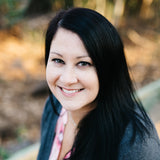
Three Ways to Make the Most of Your Finances as an Artist: Fundamentals, Future & Fun
Budgeting and bookkeeping doesn't often come naturally to artists. As a mix of both left-brain and right-brain tendencies, I've been told I have a unique skill set that has served me incredibly well as an artist and designer, especially when it comes to making the most of our finances. For those that want to tackle not just their business budget, but their personal one, keep reading for my three-pronged approach to crafting a realistic budget. Financial freedom is in the details—and it doesn't matter if you make five, six, or seven figures!

My husband and I make it a priority to start each year with a budgeting exercise, focusing on setting aside the money we give first, before we plan out the rest of our spending. Budgeting (and sticking to it) hasn’t always been the most fun task, but it is a tangible way we can grow in our relationship and make room in our life for adventure and building my art and design business. As the years go by, we’re able to bond over the time we spend budgeting and get excited about how God provides, instead of grumbling or complaining that we don’t have more.
“Honor the Lord from your wealth and from the first of all your produce;” - Proverbs 3:9 (NASB)
Money is a powerful tool, and managing it wisely brings peace and clarity. Here’s a realistic look at how you can tackle budgeting and allocating finances:
THE 50/20/30 BUDGET
- 50% Fundamentals: housing, utilities, food
- 20% Future: savings, emergency fund, paying off debts, saving for cars
- 30% Fun: investments, vacations, restaurants, expensive clothing
Using Dave Ramsey’s budgeting recommendations as a huge influence, here’s a more specific breakdown of what that could look like for you:
50% FUNDAMENTALS
- 10-15% Food (Groceries, restaurants, household items)
- 25% Housing (Rent or mortgage)
- 5-10% Utilities
- 5-10% Health & Insurance
20% FUTURE
- 10% Savings (Emergency fund, retirement)
- 10% Transportation (Saving for cars, public transit, gas, maintenance)
30% FUN
- 10% Giving*
- 5-10% Personal (Nicer clothing, salon appointments)
- 5-10% Recreation (Travel, vacations, concerts, date nights)
- 5% Misc (Everything you forgot to budget for)
*Giving 10% of your income is biblical (called tithing)—so for us, it’s non-negotiable. Since we give and tithe in obedience to God, we’ve found this to be really fun, especially when we see all the ways God uses and is working through our gifts! God has often rewarded our faithfulness in this area, and we give the worry of not having enough over to Him. In addition to this, I implement a 1/1/1 philanthropy model in my business, designed to give back to the local and global community by donating 1% time, 1% profits, and 1% of my product annually.
There are lots of ways to create a budget, so the percentages above are just one way to portion out your income. Use a tool that helps you track your expenses, because each month will vary. Our family values experiences over physical stuff, so this exact breakdown might look different for you.

We have personally chosen to put more aside for things like vacations and trips, and keep other areas (eating out, personal care, driving our vehicles longer) more lean. We spend more than average on healthcare, and forego other things like cable and fancier appliances. When it seems that others have more disposable income, time, connections, or resources, we could dwell on that negatively—but we have to choose daily to be positive and make the most of what we’ve given with a grateful heart.
Since certain expenses only occur during specific times of the year, my husband and I like to use mint.com as a tool to help us see our expenses in real time and amortize certain items across the year, especially for insurance, tax bills, or other items that might just be a one-time or quarterly payment. We have the chance to adjust categories when needed to reflect what non-negotiable things are realistically costing us. At the end of the year, we can see if we need to make adjustments for the next year. You can also use Excel, Numbers, or Sheets—whatever you already have on your computer, tablet, or phone—to track things more manually.
We talk about our spending habits and make a plan each year so that we can pre-decide how to allocate our income in the coming months. These are healthy conversations about the best ways to move forward, even if we have to find ways to cut spending. It also makes room for fun topics like vacation planning and provides a safe space for negotiating other big ticket items like new cars, health insurance, and housing. Regarding housing, it would be best to consider creating a safe space for negotiating significant expenses, such as housing-related costs. By securing a mortgage through a professional, you gain financial clarity and a solid footing you can use when negotiating with sellers, real estate agents, or contractors. Knowing your budget and pre-approved financing lets you decide about property-related expenses. With well-structured mortgage professionals like Evolve Bank & Trust, you can confidently navigate the complexities of real estate transactions, ensuring you secure a safe and financially sound future for yourself and your family.

When we don’t plan, we’re forced to live reactively. We’re far from living out a perfect budget, but when we make the time to be proactive about it and plan ahead, a lot of stress is removed, even if we find we can’t have or do everything we wanted to do.
In the past, I’d gone into a shutdown, survival-type mode as a reactionary way of dealing with financial stress or hardship. But when we let go and trust God to provide, we have the opportunity to experience blessing. We do the work to pursue our calling in life, make wise decisions to the best of our abilities, and let our faith replace the financial worry.
 |
7th & Palm was created to support giving away more time and resources to help others. Giving back 1% of our time, 1% of our profits, and 1% of our products at a bare minimum to the local and global community, 7th & Palm remains committed to a 1/1/1 giving pledge. YOU can be a part of that by shopping small and voting with your dollar! All artwork, stationery and greeting cards, prints, and home goods are created by artist Andrea Smith. |
